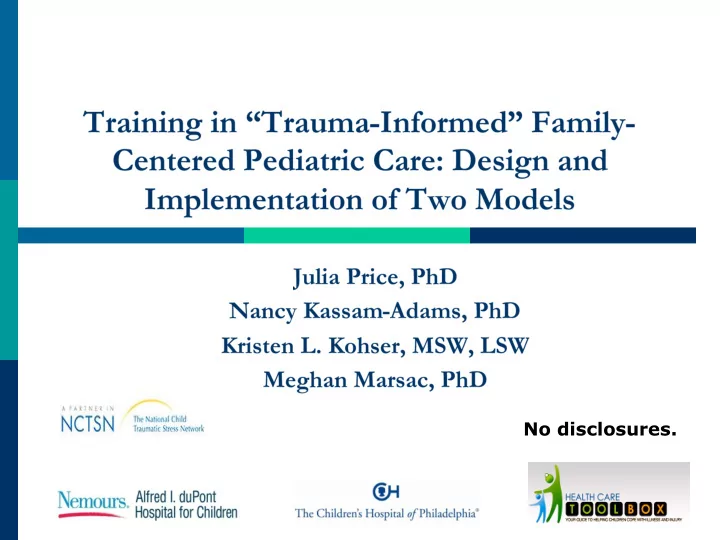

No disclosures.
“I saw my son lying in “I thought I was going the street. Bleeding, to die. I thought I must crying, the ambulance, really be hurt. I was so everybody around him. It scared because my was a horrible scene. I mom was not there.” thought I was dreaming.” “I feel like life will NEVER be the same. I don’t know if our family can get through this.” Posttraumatic stress (PTS) reactions are common in the early aftermath of an injury. Kassam-Adams, N, Marsac, ML, Hildenbrand, A, Winston, FK. (2013). Posttraumatic stress following pediatric injury: Update on diagnosis, risk factors, and intervention. JAMA: Pediatrics, 167(12):1158-1165.
have at least 1 acute PTSS in 1 st month 85% 15 - 20% significant PTSS at 6 months 5 – 10% diagnostic PTSD PTSD in youth after injury is associated with: Poorer quality of life Worse functional outcomes Holbrook, T., et al., Long-term posttraumatic stress disorder persists after major trauma in adolescents J Trauma, 2005. 58(4): p. 764-769. Zatzick et al., Association between posttraumatic stress and depressive symptoms and functional outcomes in adolescents followed up longitudinally after injury hospitalization. Arch Ped Adol Med, 2008. 162(7): p. 642-8.
Recommendation : Place a greater emphasis on the family during and after hospitalization, to mitigate the stress of pediatric trauma injury and care. Strategies : Early comprehensive psychosocial screening and assessment of children and families. Use principles of ‘‘trauma - informed care’’. Gaines, Hansen, McKenna, McMahon, Meredith, Mooney, Snow, & Upperman, for the Childress Summit of the Pediatric Trauma Society Work Groups. (2014). Report from the Childress Summit of the Pediatric Trauma Society, April 22-24, 2013. J Trauma Acute Care Surgery, 77: 504-509.
Healthcare providers have an important role in potentially preventing posttraumatic stress Trauma-informed care addresses risk factors for posttraumatic stress Acute pain Immediate emotional distress Separation from parents Parental emotional distress Few healthcare providers trained in trauma- informed care
Pre-trauma risk factors Prior traumatic experiences Prior posttraumatic stress Prior behavioral problems Peri-trauma risk factors Fear Subjective sense of life threat Pain Acute physiological arousal Separation from parents Early post-trauma risk factors Child emotional distress Problematic coping strategies Lack of strong social support network Parent emotional distress
Key elements: Minimize potentially traumatic aspects of medical care Address immediate child distress (pain, fear, loss) Frontline = MDs, Nurses Promote emotional support (help parents help their child) Social work Remember family needs Child life Chaplain (and identify family strengths) Screen to determine which patients may need more support Mental health professionals
In-Person Online Tailored trainings mostly at 4 free CE courses for Children’s Hospital of nurses Philadelphia and some local groups (school 1 overview course on nurses, teachers) medical traumatic stress Physicians, social workers, 3 specific, evidence-based nurses completed trauma-informed care practices courses Trainings typically once for Distress course 1 hour Emotion course Family course
Compared pre/post training self-report Significant improvement in provider: Understanding of trauma-informed care ( t (115)=16.3, p <.001) Ability to identify emotional reactions to trauma ( t (115)=11.2, p <.001) Ability to provide trauma-informed care ( t (115)=17.3, p <.001) Significant increase in value of trauma-informed care ( t (113)=3.8, p <.001) 86.4% would recommend the training to others
Post-online course data from providers Nurses, child life, social work Strong provider intent to implement skills 83.6% likely to provide information to parents about how to monitor child emotional and behavioral reactions ( N =146) >85% likely to use specific trauma-informed practices ( N =75) Ask about child’s distress and parents’ distress Teach family specific ways to manage procedural pain or anxiety Explain a specific procedure then check child’s understanding
Limitations Potential bias in sampling and self-report data No data on changes in provider behavior Conclusions Two complementary training models are feasible In-person training shows impressive increases in knowledge On-line training hold promise for dissemination Future research should evaluate: Provider behavior change Impact on patient care and outcomes
WEBSITE FOR PROVIDERS: www.HealthCareToolbox.org DEF Cards Patient Ed Handouts (English & Spanish) DEF Users Guide Online training
Special thanks to the children and families who have generously participated in our studies and programs. Funders: NICHD, NIMH, EMSC, MCHB, SAMHSA, CDC, Verizon Foundation, Women’s Committee of the Children’s Hospital of Philadelphia More information For health care providers www.HealthCareToolbox.org For parents of injured children www.AfterTheInjury.org TO CONTACT the Center for Pediatric Traumatic Stress: cpts@email.chop.edu
www.HealthCareToolbox.org FREE online CE courses for nurses The “how to” of implementing the DEF protocol in nursing care
Recommend
More recommend